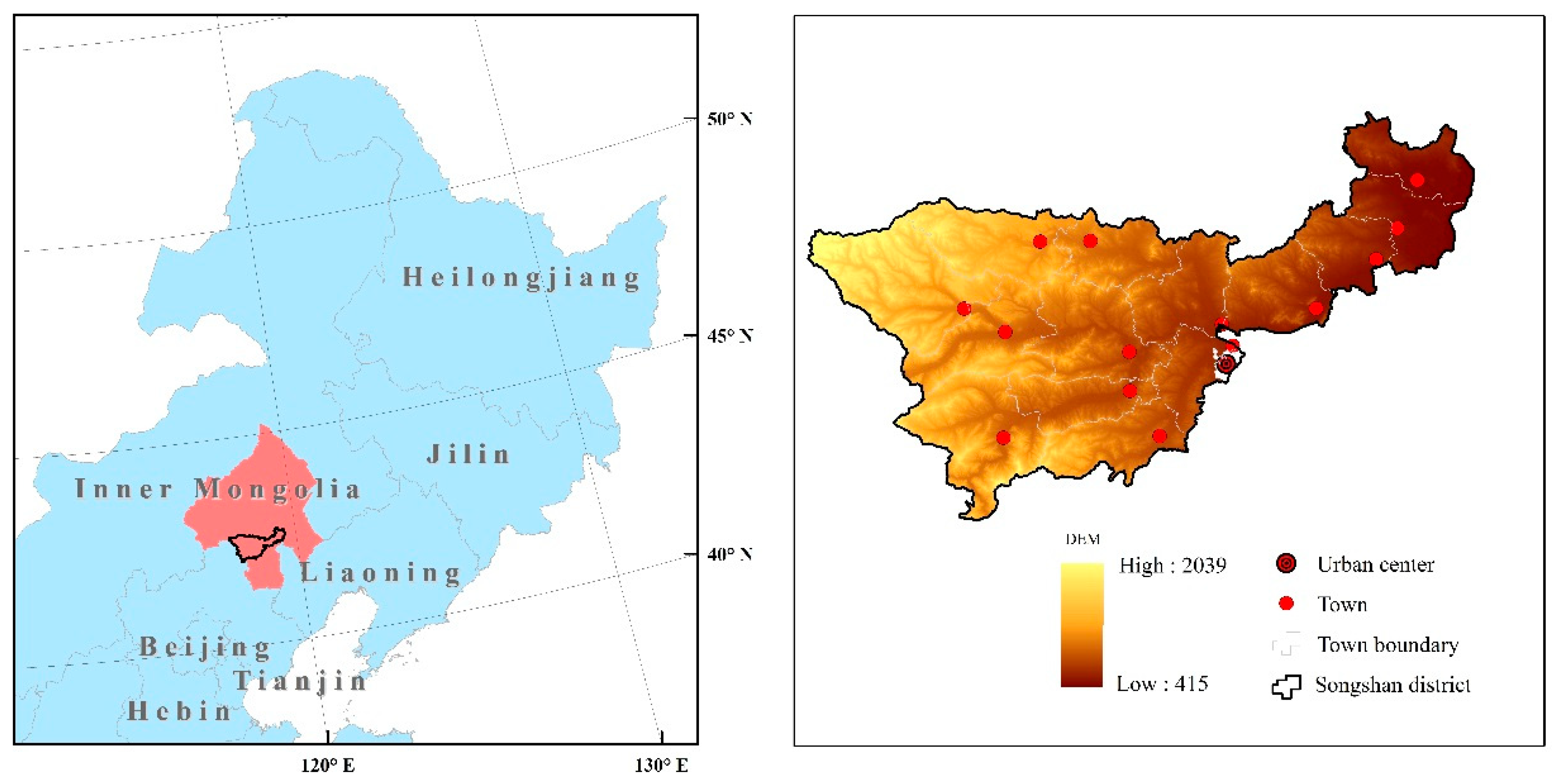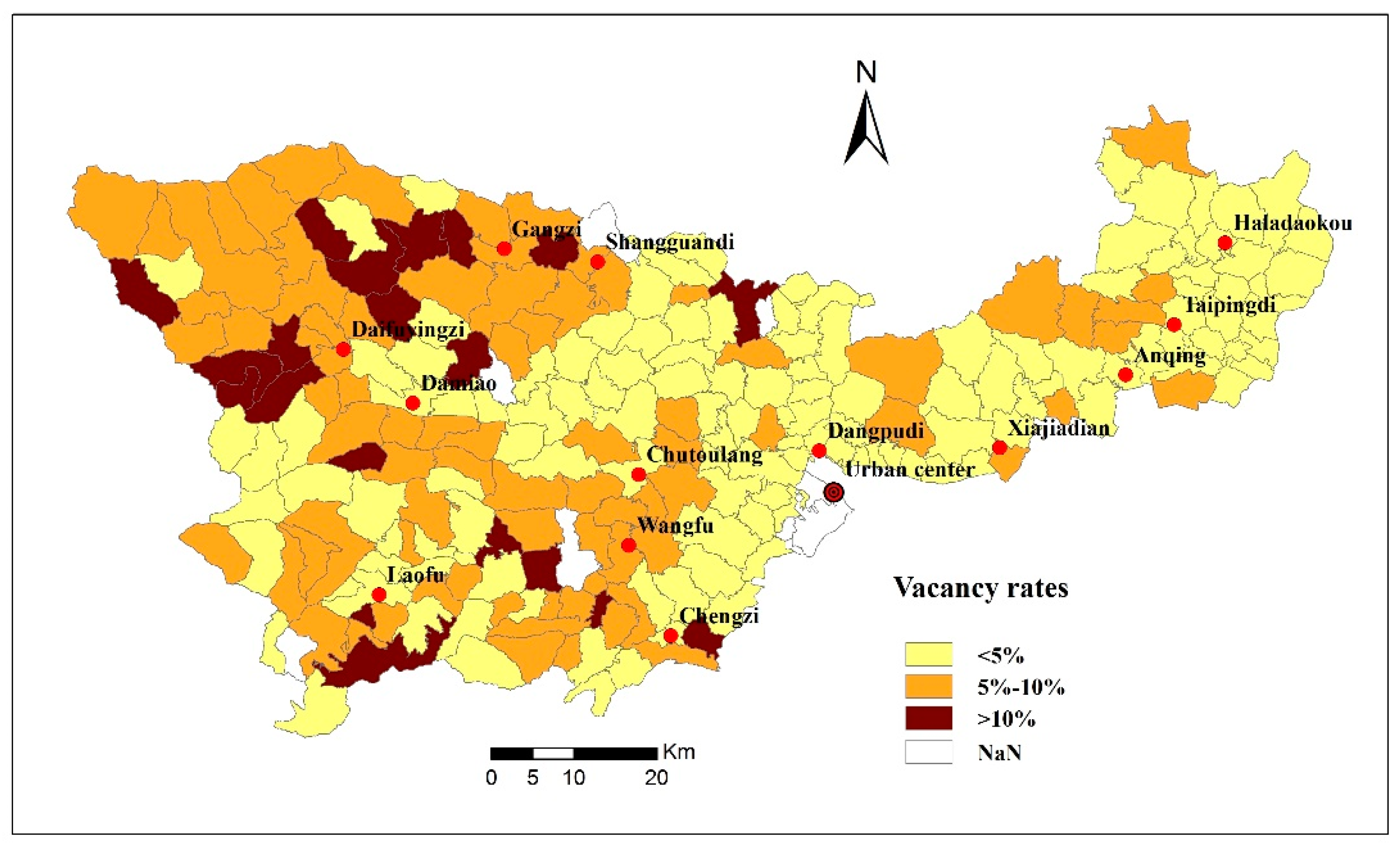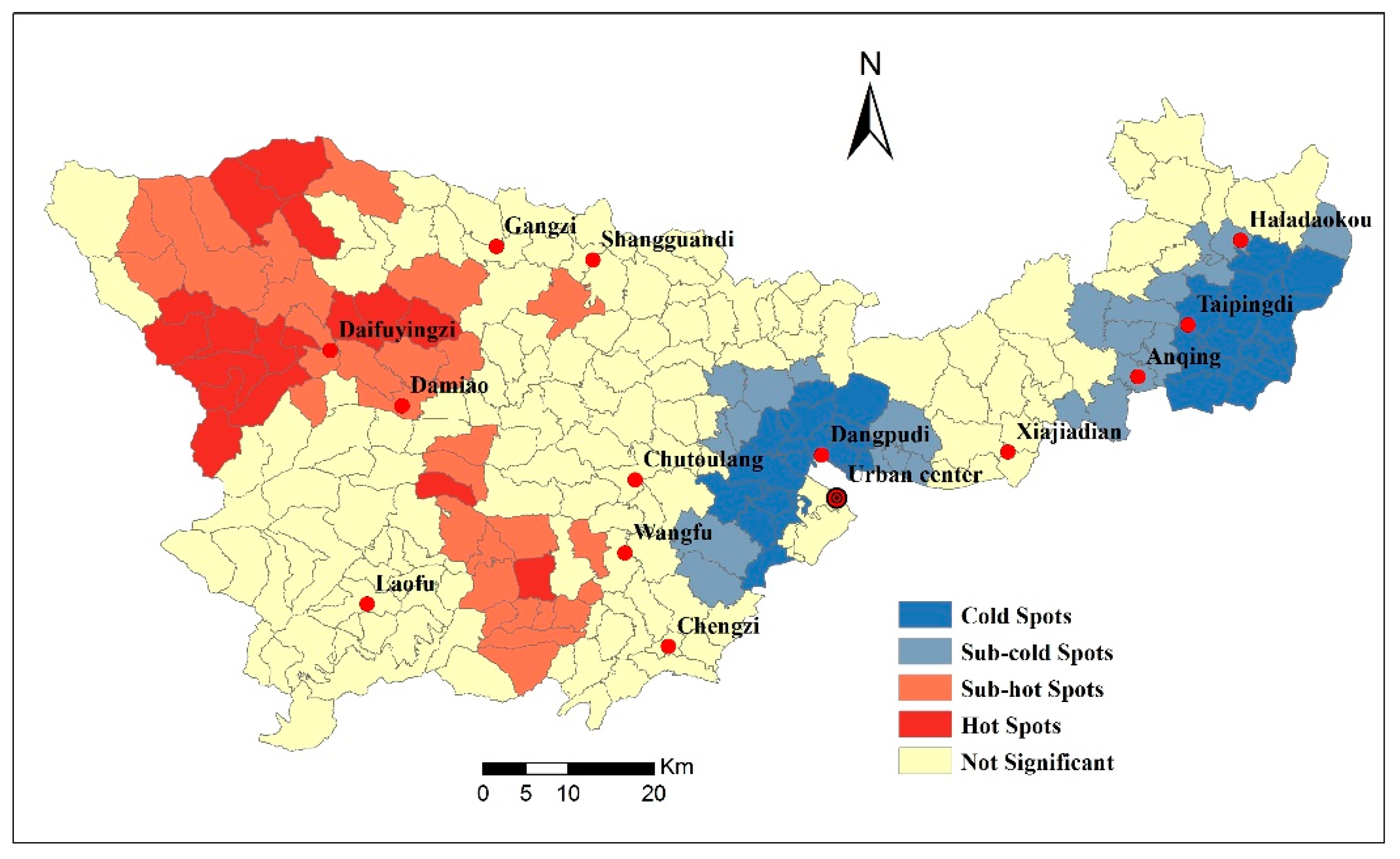Estimating Housing Vacancy Rates in Rural China Using Power Consumption Data
Abstract
1. Introduction
2. Background of China’s Rural Housing and Land Use Policy
3. Materials and Methods
3.1. Study Area
3.2. Data
3.3. Methods
3.3.1. Survey Approach
- Vacant houses are those that consumed 0–30 kWh per year;
- Underutilized houses are those that consumed 31–200 kWh per year.
3.3.2. Spatial Clustering Analysis
4. Results
4.1. Spatial and Temporal Changes of Vacant Rural Housing
4.2. Spatial and Temporal Changes of Underutilized Rural Housing
4.3. Cluster Characteristics of Vacant Rural Housing
5. Discussion
5.1. Relationship Between Terrain and Vacant Housing Rate
5.2. Relationship Between Reclamation and Vacant Housing Rate
5.3. Relationship Between Urbanization Level and Vacant Housing Rate
6. Conclusions
Author Contributions
Funding
Acknowledgments
Conflicts of Interest
References
- McGreevy, S. Lost in Translation: Incomer Organic Farmers, Local Knowledge, and the Revitalization of Upland Japanese Hamlets. Agric. Hum. Values 2012, 29, 393–412. [Google Scholar] [CrossRef]
- Lambin, E.F.; Meyfroidt, P. Land use transitions: Socio-ecological feedback versus socio-economic change. Land Use Policy 2010, 27, 108–118. [Google Scholar] [CrossRef]
- Carr, P.J.; Kefalas, M. Hollowing out the middle: The rural brain drain and what it means for America. J. Rural Soc. Sci. 2010, 291, 30–34. [Google Scholar]
- Jedwab, R.; Christiaensen, L.; Gindelsky, M. Demography, urbanization and development: Rural push, urban pull and…urban push? J. Urban Econ. 2017, 98, 6–16. [Google Scholar] [CrossRef]
- Itoh, R. Dynamic control of rural–urban migration. J. Urban Econ. 2009, 66, 196–202. [Google Scholar] [CrossRef]
- Kojima, R. Urbanization in China. Dev. Econ. 1995, 33, 121–154. [Google Scholar] [CrossRef]
- Friedmann, J. Four theses in study of China’s urbanization. China City Plan. Rev. 2006, 30, 440–451. [Google Scholar] [CrossRef]
- Li, Y.; Jia, L.; Wu, W.; Yan, J.; Liu, Y. Urbanization for rural sustainability—Rethinking China’s urbanization strategy. J. Clean. Prod. 2018, 178, 580–586. [Google Scholar] [CrossRef]
- Ao, X.; Jiang, D.; Zhao, Z. The impact of rural–urban migration on the health of the left-behind parents. China Econ. Rev. 2016, 37, 126–139. [Google Scholar] [CrossRef]
- Seto, K.C.; Michail, F.; Burak, G.; Reilly, M.K. A meta-analysis of global urban land expansion. PLoS ONE 2011, 6, e23777. [Google Scholar] [CrossRef]
- National Bureau of Statistics. China Statistical Yearbook 2017; China Statistics Press: Beijing, China, 2017.
- Tan, M.; Li, X. The changing settlements in rural areas under urban pressure in china: Patterns, driving forces and policy implications. Landsc. Urban Plan. 2013, 120, 170–177. [Google Scholar] [CrossRef]
- Long, H.; Liu, Y.; Li, X.; Chen, Y. Building new countryside in China: A geographical perspective. Land Use Policy 2010, 27, 457–470. [Google Scholar] [CrossRef]
- Liu, Y.; Liu, Y.; Chen, Y.; Long, H. The process and driving forces of rural hollowing in china under rapid urbanization. J. Geogr. Sci. 2010, 20, 876–888. [Google Scholar] [CrossRef]
- Qin, H.; Liao, T.F. Labor out-migration and agricultural change in rural china: A systematic review and meta-analysis. J. Rural Stud. 2016, 47, 533–541. [Google Scholar] [CrossRef]
- Wang, L. Research on the Response of Rural Residential Land Idle and Withdrawal based on Household Characteristics—Yining City as an Example. Master’s Thesis, Xinjiang Agricultural University, Xinjiang, China, 2016. [Google Scholar]
- Liu, Y.; Lu, S.; Chen, Y. Spatio-temporal change of urban–rural equalized development patterns in china and its driving factors. J. Rural Stud. 2013, 32, 320–330. [Google Scholar] [CrossRef]
- Li, Y.; Long, H.; Liu, Y. Spatio-temporal pattern of china’s rural development: A rurality index perspective. J. Rural Stud. 2015, 38, 12–26. [Google Scholar] [CrossRef]
- Tu, S.; Long, H.; Zhang, Y.; Ge, D.; Qu, Y. Rural restructuring at village level under rapid urbanization in metropolitan suburbs of china and its implications for innovations in land use policy. Habitat Int. 2018, 77, 143–152. [Google Scholar] [CrossRef]
- Li, Y.; Wu, W.; Liu, Y. Land consolidation for rural sustainability in china: Practical reflections and policy implications. Land Use Policy 2018, 74, 137–141. [Google Scholar] [CrossRef]
- Molloy, R. Long-term vacant housing in the United States. Reg. Sci. Urban Econ. 2016, 59, 118–129. [Google Scholar] [CrossRef]
- Newman, G.D.; Bowman, A.O.M.; Lee, R.J.; Kim, B. A current inventory of vacant urban land in America. J. Urban Des. 2016, 21, 302–319. [Google Scholar] [CrossRef]
- Song, H. “Hollow village” evolution and policy control from the perspective of rural urbanization: A case study of Jiangsu province. Asian Agric. Res. 2016, 08, 22–26. [Google Scholar]
- Li, T.; Long, H.; Liu, Y.; Tu, S. Multi-scale analysis of rural housing land transition under china’s rapid urbanization: The case of Bohai Rim. Habitat Int. 2015, 48, 227–238. [Google Scholar] [CrossRef]
- Long, H.; Heilig, G.K.; Li, X.; Zhang, M. Socio-economic development and land-use change: Analysis of rural housing land transition in the transect of the Yangtse River, China. Land Use Policy 2007, 24, 141–153. [Google Scholar] [CrossRef]
- Fang, Y.-G.; Shi, K.-J.; Niu, C.-C. A comparison of the means and ends of rural construction land consolidation: Case studies of villagers’ attitudes and behaviours in changchun city, Jilin province, China. J. Rural Stud. 2016, 47, 459–473. [Google Scholar] [CrossRef]
- Song, W.; Chen, B.; Zhang, Y. Typical survey and analysis on influencing factors of village-hollowing of rural housing land in China. Geogr. Res. 2013, 32, 20–28. [Google Scholar]
- Deng, C.; Li, K.; Peng, C.; Han, F. Analysis of technological progress and input prices on electricity consumption: Evidence from china. J. Clean. Prod. 2018, 196, 1390–1406. [Google Scholar] [CrossRef]
- Chen, W.; Zhou, K.; Yang, S.; Wu, C. Data quality of electricity consumption data in a smart grid environment. Renew. Sustain. Energy Rev. 2017, 75, 98–105. [Google Scholar] [CrossRef]
- Guo, Z.; Zhou, K.; Zhang, X.; Yang, S.; Shao, Z. Data mining based framework for exploring household electricity consumption patterns: A case study in China context. J. Clean. Prod. 2018, 195, 773–785. [Google Scholar] [CrossRef]
- Zhao, X.; Chen, H.; Ma, Y.; Gao, Z.; Xue, B. Spatio-temporal variation and its influencing factors of rural energy poverty in china from 2000 to 2015. Geogr. Res. 2018, 37, 1115–1126. [Google Scholar]
- Liao, H. Residential energy consumption in rural china: Situation, problems and solutions. J. Beijing Inst. Technol. 2019, 21, 1–5. [Google Scholar]
- Huang, X.; Li, H.; Zhang, X.; Zhang, X. Land use policy as an instrument of rural resilience—The case of land withdrawal mechanism for rural homesteads in China. Ecol. Indic. 2018, 87, 47–55. [Google Scholar] [CrossRef]
- Zhu, X.; Chen, L.; Fu, J. Tendency and implication of rural residential land system change. China Land Sci. 2012, 26, 39–43. [Google Scholar]
- Wu, Y.; Mo, Z.; Peng, Y.; Skitmore, M. Market-driven land nationalization in china: A new system for the capitalization of rural homesteads. Land Use Policy 2018, 70, 559–569. [Google Scholar] [CrossRef]
- Yu, Z.; Wu, C.; Tan, Y.; Zhang, X. The dilemma of land expansion and governance in rural china: A comparative study based on three townships in Zhejiang province. Land Use Policy 2018, 71, 602–611. [Google Scholar] [CrossRef]
- Zou, B.; Mishra, A.K.; Luo, B. Aging population, farm succession, and farmland usage: Evidence from rural China. Land Use Policy 2018, 77, 437–445. [Google Scholar] [CrossRef]
- Long, K.; Liu, C.; Chen, L. Analysis on peasants’ willingness-to-accept and its influencing factors of governance patterns about rural idle residential land. China Popul. Resour. Environ. 2012, 22, 83–89. [Google Scholar]
- Chen, H.; Zhao, L.; Zhao, Z. Influencing factors of farmers’ willingness to withdraw from rural homesteads: A survey in Zhejiang, China. Land Use Policy 2017, 68, 524–530. [Google Scholar] [CrossRef]
- Xue, P.; He, C.; Liu, S. Analysis on present situation and influencing factors of rural settlement hollowing in the hilly and mountainous area in Sichuan. Guangdong Agric. Sci. 2013, 40, 207–210. [Google Scholar]
- Meng, X.; Xin, B. Clear right of use: The way to solve the problem of rural homestead waste. Rural Econ. 2006, 13–15. [Google Scholar]
- Kong, X.; Liu, Y.; Jiang, P.; Tian, Y.; Zou, Y. A novel framework for rural homestead land transfer under collective ownership in China. Land Use Policy 2018, 78, 138–146. [Google Scholar] [CrossRef]
- Long, H.; Tu, S.; Ge, D.; Li, T.; Liu, Y. The allocation and management of critical resources in rural china under restructuring: Problems and prospects. J. Rural Stud. 2016, 47, 392–412. [Google Scholar] [CrossRef]
- Hu, Z.; Peng, J.; Du, Y.; Song, Z.; Liu, Y.; Wang, Y. Reconstructing hollow villages in the view of structural reform of the supply side. Acta Geogr. Sin. 2016, 71, 2119–2128. [Google Scholar]
- Long, H.; Li, Y.; Liu, Y.; Woods, M.; Zou, J. Accelerated restructuring in rural china fueled by ‘increasing vs. Decreasing balance’ land-use policy for dealing with hollowed villages. Land Use Policy 2012, 29, 11–22. [Google Scholar] [CrossRef]
- Sun, S.; Meng, Y. On background, influencing factors, model and future of rural land circulation—Review and explanation of the policy. Theory J. 2015, 37–45. [Google Scholar]
- Wu, Y.; Sun, X. The review and prospect of land use policy in china after the 40 years of reform and opening up: An urbanization perspective. China Land Sci. 2018, 32, 7–14. [Google Scholar]
- Sheng, Y.; Qin, F.; Wang, G.; Bao, S. Simulation of cultivated land evolution in songshan district of Chifeng city. Bull. Soil Water Conserv. 2017, 37, 206–211+202. [Google Scholar]
- Deng, X.; Xu, Y.; Han, L.; Yang, M.; Yang, L.; Song, S.; Li, G.; Wang, Y. Spatial–temporal evolution of the distribution pattern of river systems in the plain river network region of the Taihu Basin, China. Quat. Int. 2016, 392, 178–186. [Google Scholar] [CrossRef]
- Liu, Q.; Wang, S.; Zhang, W.; Li, J.; Kong, Y. Examining the effects of income inequality on co2 emissions: Evidence from non-spatial and spatial perspectives. Appl. Energ. 2019, 236, 163–171. [Google Scholar] [CrossRef]
- Chang, B.A.; Pearson, W.S.; Owusu-Edusei, K. Correlates of county-level nonviral sexually transmitted infection hot spots in the us: Application of hot spot analysis and spatial logistic regression. Ann. Epidemiol. 2017, 27, 231–237. [Google Scholar] [CrossRef]
- Getis, A.; Ord, J.K. The analysis of spatial association by use of distance statistics. Geogr. Anal. 1992, 24, 189–206. [Google Scholar] [CrossRef]
- Maina, I.; Kavadas, S.; Katsanevakis, S.; Somarakis, S.; Tserpes, G.; Georgakarakos, S. A methodological approach to identify fishing grounds: A case study on Greek Trawlers. Fish. Res. 2016, 183, 326–339. [Google Scholar] [CrossRef]
- Hsueh, Y.-H.; Lee, J.; Beltz, L. Spatio-temporal patterns of dengue fever cases in Kaoshiung city, Taiwan, 2003–2008. Appl. Geogr. 2012, 34, 587–594. [Google Scholar] [CrossRef]
- Liu, Y.; Liu, Y. Progress and prospect on the study of rural hollowing in china. Geogr. Res. 2010, 29, 35–42. [Google Scholar]
- Yılmaz, B.; Daşdemir, İ.; Atmiş, E.; Lise, W. Factors affecting rural development in Turkey: Bartın case study. Policy Econ 2010, 12, 239–249. [Google Scholar] [CrossRef]
- Liu, S.; Xie, F.; Zhang, H.; Guo, S. Influences on rural migrant workers’ selection of employment location in the mountainous and upland areas of Sichuan, China. J. Rural Stud. 2014, 33, 71–81. [Google Scholar] [CrossRef]
- Wang, G. Analysis on governance characteristics of rural hollowing in Japan. World Agric. 2015, 53–57. [Google Scholar]
- Li, Y.; Westlund, H.; Zheng, X.; Liu, Y. Bottom-up initiatives and revival in the face of rural decline: Case studies from China and Sweden. J. Rural Stud. 2016, 47, 506–513. [Google Scholar] [CrossRef]
- Zhao, Q.; Zhang, Z. Does china’s ‘increasing versus decreasing balance’ land-restructuring policy restructure rural life? Evidence from dongfan village, Shaanxi Province. Land Use Policy 2017, 68, 649–659. [Google Scholar] [CrossRef]
- Yu, L.; Sun, D.; Zhang, D.; Zheng, B.; Han, L.; Yu, Z. Rural household survey based analysis of hollowing of rural residential land in China. Sci. Geogr. Sin. 2016, 36, 1043–1049. [Google Scholar]
- Zheng, Q.; Zeng, Y.; Deng, J.; Wang, K.; Jiang, R.; Ye, Z. “Ghost cities” identification using multi-source remote sensing datasets: A case study in Yangtze River Delta. Appl. Geogr. 2017, 80, 112–121. [Google Scholar] [CrossRef]
- Chen, X. From rural reform 40 years to see the proposal of rural revitalization strategy. Rural Oper. Manag. 2018, 6–10. [Google Scholar]








| Elevation | Vacancy Rate (%) | Underutilization Rate (%) | ||
|---|---|---|---|---|
| 2014 | 2017 | 2014 | 2017 | |
| >1000 m | 7.41 | 11.48 | 13.33 | 11.11 |
| 700 < elevation ≤ 1000 m | 5.30 | 9.07 | 9.84 | 9.17 |
| ≤ 700 m | 3.45 | 5.88 | 6.81 | 6.81 |
© 2019 by the authors. Licensee MDPI, Basel, Switzerland. This article is an open access article distributed under the terms and conditions of the Creative Commons Attribution (CC BY) license (http://creativecommons.org/licenses/by/4.0/).
Share and Cite
Li, J.; Guo, M.; Lo, K. Estimating Housing Vacancy Rates in Rural China Using Power Consumption Data. Sustainability 2019, 11, 5722. https://doi.org/10.3390/su11205722
Li J, Guo M, Lo K. Estimating Housing Vacancy Rates in Rural China Using Power Consumption Data. Sustainability. 2019; 11(20):5722. https://doi.org/10.3390/su11205722
Chicago/Turabian StyleLi, Jing, Meng Guo, and Kevin Lo. 2019. "Estimating Housing Vacancy Rates in Rural China Using Power Consumption Data" Sustainability 11, no. 20: 5722. https://doi.org/10.3390/su11205722
APA StyleLi, J., Guo, M., & Lo, K. (2019). Estimating Housing Vacancy Rates in Rural China Using Power Consumption Data. Sustainability, 11(20), 5722. https://doi.org/10.3390/su11205722







